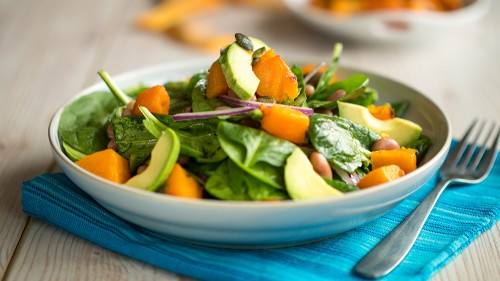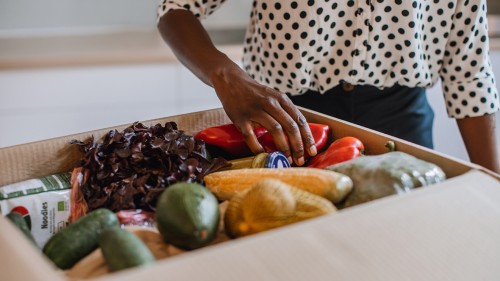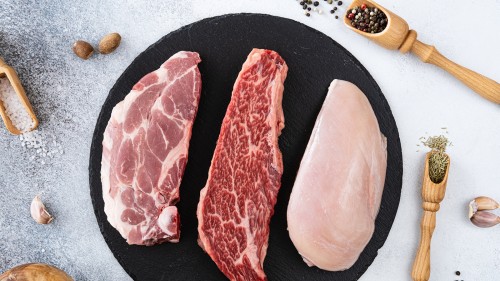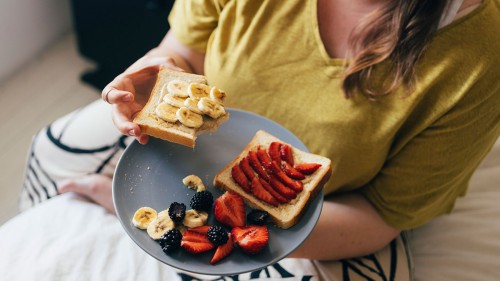How to Meal Prep: A 10-Step Beginner’s Guide
Published on February 25, 2022
Medically Reviewed by Natalie Olsen, MS, RDN
Meal prep is the smart way to make healthy eating a sustainable part of your life. If you’re new to meal prepping and are considering adding it to your life, you may be intimidated by taking it on. This 10-step beginner’s guide to meal prep will give you the confidence you need to meal prep effectively — even if you’re not the most chef-savvy.

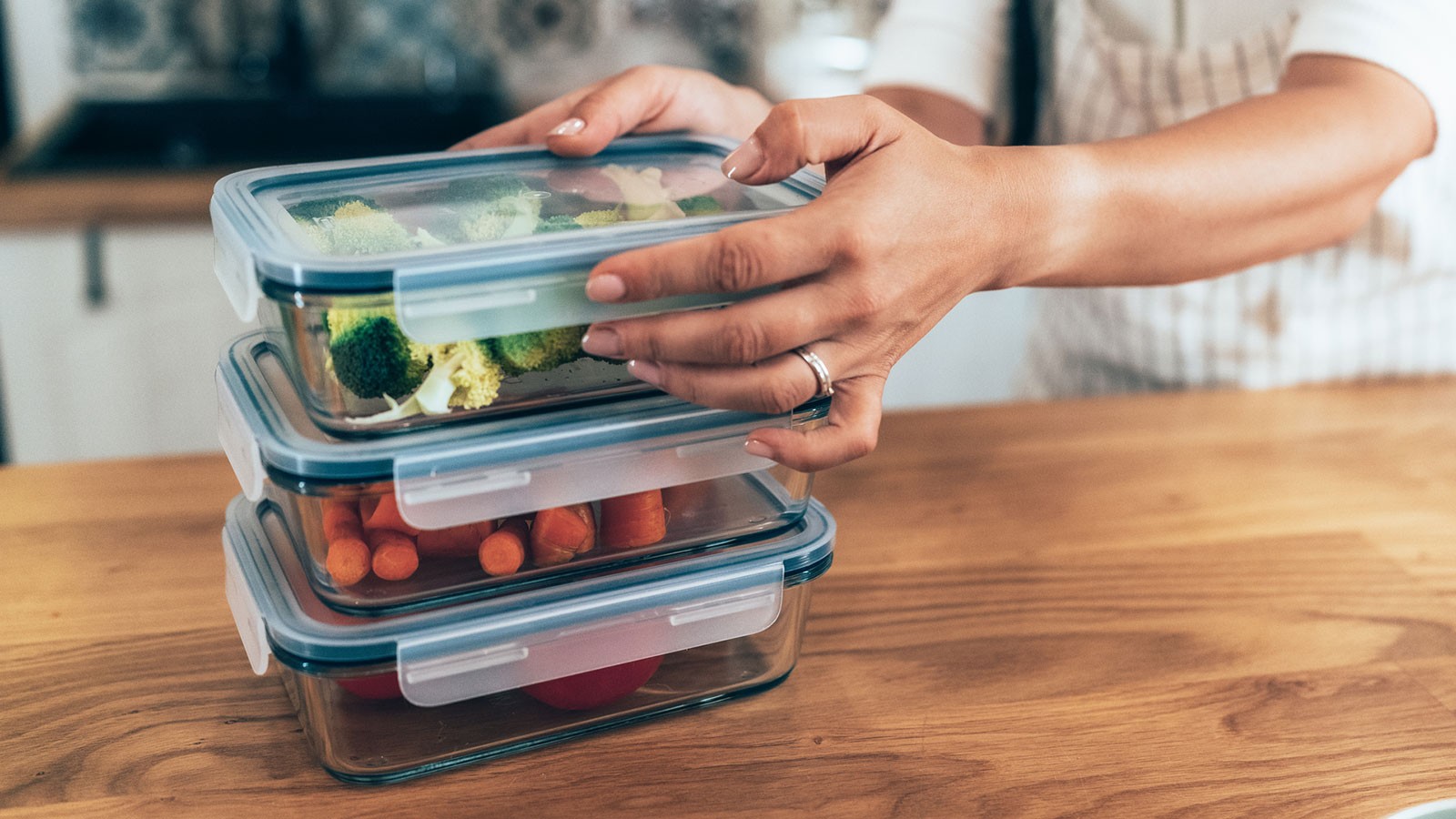
Busy work schedules, never-ending to-do lists, and afterschool activities may make the convenience of drive-thru meals more appealing.
Americans today spend less time prepping food and cooking than in the 1960s, with an average of 33 minutes spent daily on food prep and kitchen clean-up. (1)
Some may avoid meal prep because of a lack of time or cooking skills. But, meal prepping doesn’t have to take loads of time, and you don’t have to be a world-class chef to make meals at home.
There’s no one-size-fits-all and no perfect way to prep meals; it’s just about what works best for you.
This article will cover everything you need to know about how to meal prep.
What Is Meal Prep?
Some of the best things in life come from having a plan. Vacations, fitness marathons, graduations, and weddings all happen from planning.
To start, you can’t meal prep without meal planning. You might be wondering the difference between meal prepping and meal planning.
One study defines a meal plan as planning what you’ll eat over the next few days. (2) Meal plans are goals, while meal prep takes action to accomplish the goals.
Meal prep is the act of preparing foods that you’re planning to eat over the next few days.
If you’re considering adding meal prep into your life, you probably feel it has benefits. Though meal prepping takes some work, the idea is to help make your life easier.
Summary
Meal prep is preparing the foods in your meal plan that you’ll eat in the future.
Benefits of Meal Prepping
It’s a Fast Track to Reaching Your Health Goals
Healthy meal prepping can put you in the driver’s seat to improve your health.
Whether you want to lose weight, stop skipping breakfast, or eat more plant-based foods, prepping meals can help make sure you have quick access to healthy foods without hassle so you can follow your commitment to better health.
It Saves Time and Money
The idea of cooking night after night after a long day of work can be daunting. Meal prepping can eliminate or reduce the time spent cooking because the bulk of the work is already complete.
Meal prepping can also save money from ordering less takeout.
A 2017 study surveying 1,319 adults and meal behaviors found that those who spent under one hour a day meal prepping were more likely to eat fast food. They were also more likely to spend large amounts of money than those who spent more time on meal prep. (3)
It Helps Prevent Food Waste
In my experience, I’ve heard many patients complain about their fruits and vegetables going bad quickly. You may have had the same frustrations.
Fruits and vegetables will spoil when there’s no plan for their use. Meal prep can help reduce food waste because you’ll utilize fruits and vegetables in your recipes and prep them to eat while they’re still fresh and ready.
Summary
Meal prep can help enhance your health by getting you closer to reaching your health goals.
It will essentially save you time because you won’t be cooking and cleaning up as often.
With fewer trips to the restaurants and using the foods you have on hand before they spoil, you’ll save money too.
Different Ways to Prep Meals
Make-Ahead Freezer Meals
These are the kinds of meals families are gifted when a new baby has been born and life is too hectic to cook meals at home.
Make-ahead freezer meals are made with plans for eating in the next few weeks or months.
Meal Prep for a Week
Prepping meals for the week might be the most common meal prep method and will be the focus of this beginner’s guide.
Weekly meals provide meals that last several days to a week, whether for breakfast, lunch, dinner, or all three.
Ingredient Prep
Preparing ingredients can involve pre-cutting fruits and vegetables, hard boiling eggs, thawing frozen meat in the fridge, or soaking beans for future use.
You can do these small things to whip up a meal in less time. Ingredient prep can make cooking go quicker or healthy snacks for on the go.
Summary
There are many ways to prep meals and the method you choose can change from week to week based on your needs.
You can meal prep freezer meals for months ahead of time, prep ingredients for the day, or meal prep for the week. The best method is the one that fits into your lifestyle.
10 Steps on How to Meal Prep for the Week
1. Choose What Types of Meals You Want to Prep
Whether it’s planning quick breakfasts so you can eat on your way to work, or making sure the kids get a healthy dinner after soccer practice, meal planning starts with considering your needs and goals.
It helps keep things simple to choose one type of meal to prep for the week. Maybe this week, you’ll focus on prepping dinners.
2. Gather Three Recipes
Pinterest boards and Instagram will have you wanting to prep ten meals this week. Remember, meal prepping is a marathon, not a sprint.
Consider gathering three recipes with positive ratings, ten ingredients or less, and use similar ingredients. That way, there’s a good chance they’re tasty, easier to make, and simpler to prep if the recipes call for similar items.
If you can add the fourth recipe, stick to something low maintenance that doesn’t require much supervision, like a slow cooker recipe.
3. Make a Grocery List
Read through your recipe ingredients list and decide what you’ll need to get from the grocery store to make the recipes.
Make a list on your cell phone, so you’ll be more likely to have it with you while you’re aisle strolling.
4. Schedule a Time Block for Grocery Shopping and Meal Prep
Create time in your calendar for grocery shopping and meal prep just like you would if you had a dental appointment.
Commit to your plans by scheduling grocery shopping and meal prep into your calendar. Many people like to grocery shop and meal plan on the weekends when there is more time.
5. Start and End with a Clean Space
When you’re ready to start meal prepping, make sure you’re starting with a clean kitchen to lessen clean-up time and reduce frustrations during meal prep.
While you’re cooking, try your best to clean pots and wipe spills as you go to avoid being overwhelmed with a mess.
6. Strategize Your Recipe Order
Start with your longest recipe first or the recipe that has the longest cooking time, so you’re able to prep other recipes while it cooks.
You might have a recipe that needs to roast for 30 minutes or a slow cooker soup that needs to simmer for an hour. These are great times to get moving on your other recipes.
7. Pull Out the Necessary Spices and Seasonings
If your recipe calls for lots of flavor agents like spices and seasonings, it may help to get them off the spice rack early and line them up.
Sometimes, locating these ingredients can take a while, and having them ready to measure will help things go faster.
8. Chop Your Produce First
Things can move along quicker if you consider chopping all your vegetables from all recipes at one time and separating them into bowls until it’s time to use them.
That way, you won’t need to cut any more veggies when it’s time to prep your meat, and there’s less risk of cross-contamination with ingredients that may contain harmful bacteria like raw meat or eggs.
9. Prep Your Proteins and Set Them Side
Since you’ve already cut your produce, there’s no need to worry about cross-contaminating foods on the cutting board with raw meat.
Always cut raw meat separately from other foods to avoid food-borne illness.
Related: Nutritious Protein-Rich Foods That Offer More
10. Store and Label Your Meals
When your meals are finished and cooled, you can determine how to store them.
The best storage supplies will help keep your foods fresh and retain their flavor. Labeling your meals will help you track how long they’ve been in the refrigerator.
If you want to freeze your meals for the future, you can pre-portion them in small containers to make them easier to reheat as needed.
Recommended storage supplies to have on-hand:
- Reusable storage bags
- Freezer bags
- Glass storage containers
- Meal prep containers
- Mason jars
Summary
The first step to meal prepping for the week is planning what you’ll make. Choose what types of meals you’ll be preparing, find three recipes, and schedule a time to grocery shop and prep.
The next step is starting the cooking. It helps to begin with a clean space and prep the longest recipe first. Get spices and seasonings out of the cabinet, chop produce before handling raw meat, and label your meals before storing.
Food Prep Tips
Choose Weekly Themes
Choosing weekly themes can help get your family involved in meal planning. It also makes a fun way to have cooking competitions at home.
Making similar dishes in your meal prep can also help to save time when cooking with similar ingredients.
Weekly theme ideas:
- Rice bowls
- Tacos
- Stir-fries
- Soups and flatbread
- Sheet pan dinners
- Pasta
Take Meal Prep Shortcuts
There’s no perfect way to meal prep, and taking shortcuts is okay. Here are some examples of ingredients that make meal prep more doable when you’re short on time.
Meal prep shortcut foods:
- Rotisserie chicken
- Canned protein (chicken, fish)
- Canned beans
- Canned vegetables and fruit
- Microwavable grains and legumes
- Steamable frozen vegetable bags
- Pre-cut vegetables and fruit
Kitchen Equipment Are Your Friends
It might be time to dust off the kitchen equipment. Your kitchen equipment can help you successfully create healthy meals in less time. Here are ideas of the kitchen equipment you may have in your home.
Kitchen equipment for meal prepping:
- Slow cooker
- Instant pot
- Rice cooker
- Steamer
- Food processor
- Spiralizer
- Egg cooker
Enlist Help
Involve your family in meal prep to expose your kids to cooking. Cooking together can help you and your family bond, make healthier choices and reduce picky eating.
You can also involve friends in meal prepping so they too can get ahead on their weekly meals.
Meal prep help may also include signing up for a meal delivery service. Though these services can be costly, they can also deliver healthy ingredients to your door and give you each step you need to cook your meal in no time.
Summary
Choosing weekly themes can make meal prep more fun and help you try new recipes.
Simplify meal prepping by taking shortcuts. For example, rotisserie chicken and pre-cut vegetables are healthy meal prep shortcuts that save time.
Frequently Asked Questions
Is meal prepping worth it?
Preparing your meals in advance has many benefits.
It can save you time and money and help your intent to eat healthier.
Meal prepping can also reduce how often you eat fast food or restaurant foods, typically offering high-fat and high-sodium foods that may compromise your health goals.
So yes, meal prepping is worth it.
Will meal prepping help lose weight?
There’s no guarantee that meal prepping will help you lose weight, but it’s possible.
Healthy meal prepping may help with weight loss because you may be less likely to skip meals, overeat, or frequent fast foods restaurants.
In a 2015 study, there was a link between increased time spent meal prepping to eating more fresh fruits, vegetables, and salads. (3)
Increasing your intake of these foods might help promote weight loss.
Is food prep for a week safe?
Safely storing foods depends on the types of foods you’re cooking. For example, if you’re prepping a casserole, it’s best to keep it in the fridge for 3–4 days.
You can use the USDA’s “Food Keeper” app to determine safe food storage guidelines.
How often should I meal prep?
Meal prep will look different from person to person. You should meal prep as often as your schedule allows. Many people like to meal prep 1–3 times per week. Others may prefer to prep meals daily.
Is meal prepping healthy?
Meal prepping is healthy as long as you’re preparing a variety of foods such as whole grains, beans and legumes, lean proteins, low-fat dairy, healthy fats, fruits, and vegetables.
The Bottom Line
Preparing your meals ahead of time can improve the quality of your diet, save you time and money, and help grow your cooking skills.
If you’re new to meal prepping, you might consider giving it a try to see how it benefits you.
Getting started is the biggest hurdle, and following these 10 steps and extra food prep tips can simplify the process for you.
Though it may be overwhelming to start something new, meal prepping is always working for your good by making healthy eating more available to you.
Remember, there’s no one-size-fits-all approach to meal planning, and you can tailor it to meet the needs of your lifestyle.
At WellnessVerge, we only use reputable sources, including peer-reviewed medical journals and well-respected academic institutions.
- Time Spent on Home Food Preparation and Indicators of Healthy Eating - PMC:
https://www.ncbi.nlm.nih.gov/labs/pmc/articles/PMC4254327/#R4 - Meal planning is associated with food variety, diet quality and body weight status in a large sample of French adults - PubMed:
https://pubmed.ncbi.nlm.nih.gov/28153017/ - Time Spent on Home Food Preparation and Indicators of Healthy Eating - PMC:
https://www.ncbi.nlm.nih.gov/labs/pmc/articles/PMC4254327/


